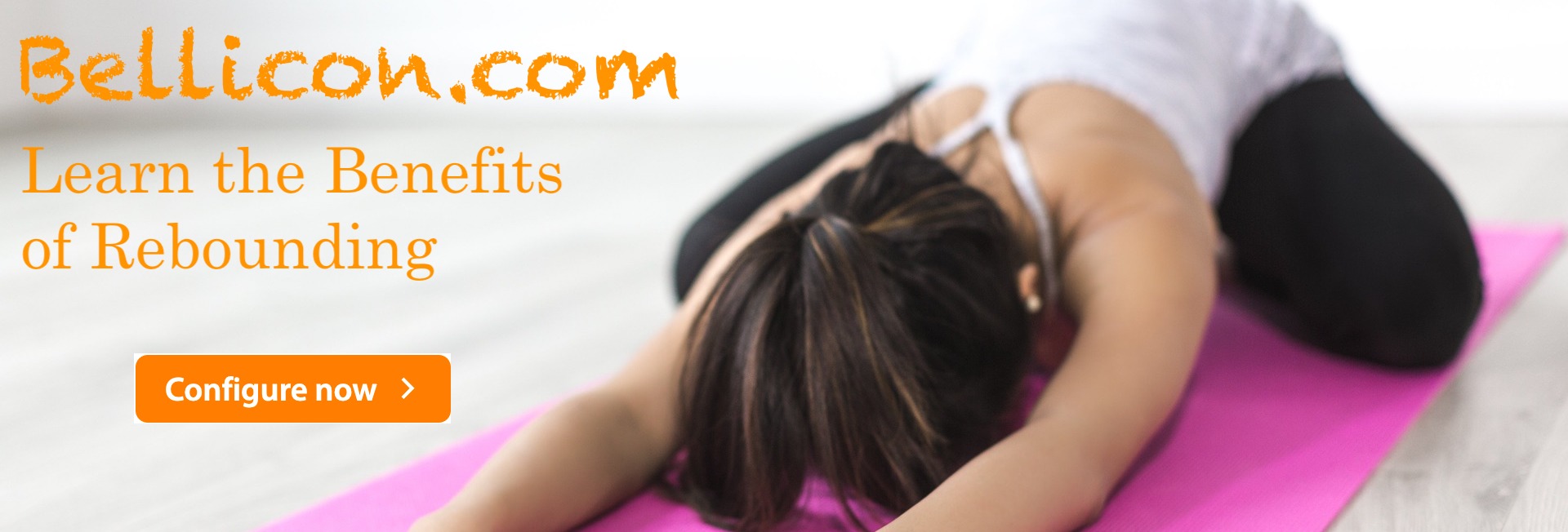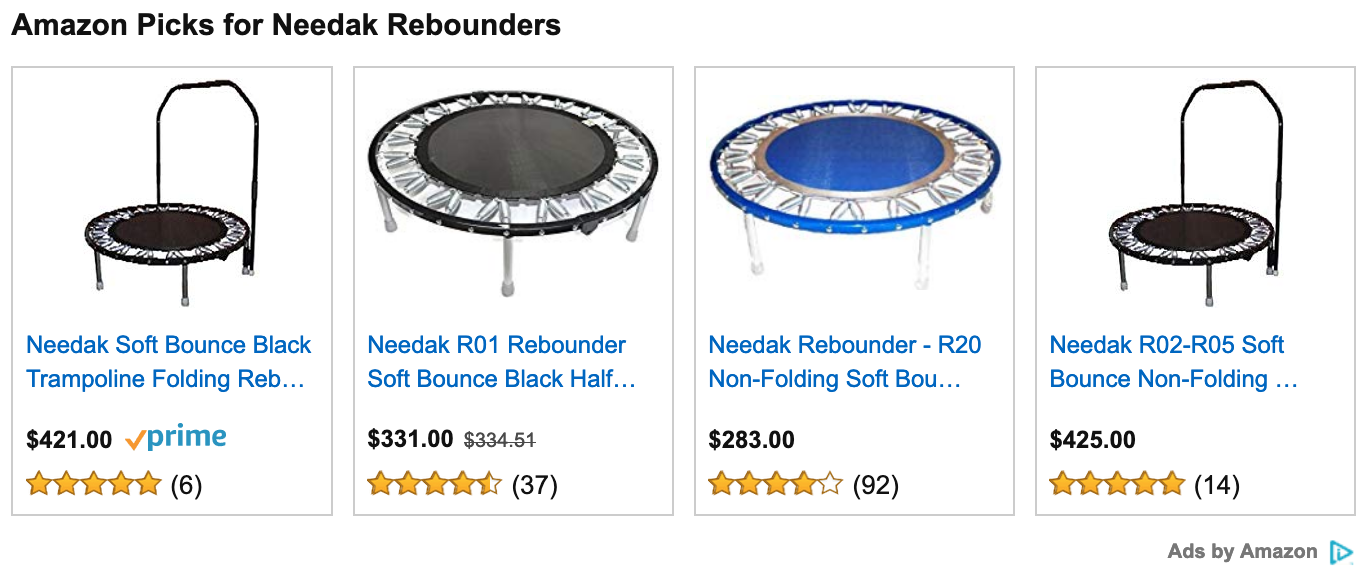Try these Basic Rebounder Exercises to Get the Most Out of Your Workouts
I bet you're thinking, "Don't I just jump up and down on it?"
Rebounder exercises have a little more to them than that.
So, how to rebound...?
There are generally four basic categories of bounces to get the most out of this mini trampoline exercise:
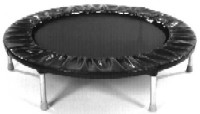
These are going to be mostly self-explanatory, so I won't go into too much detail. You can incorporate them all into a fun rebounder workout.
However, as a word of caution, please do not overexert yourself when first using a rebounder. It can be tempting because it seems like such an easy exercise, but when first beginning moderation is the key.
Rebounding has a profound effect on your body, so take it slow. After all, when was the last time you exercised your liver, kidneys, and spleen? See my point? Don't shock your system.
Also, a few words of advice to beginning bouncers:
- If you feel pain anywhere, stop bouncing and try again at another time. Listen to your body as you adjust to your new exercise routine.
- If you feel tingly sensations in your arms, legs, buttocks (anywhere really), this should not concern you. It is actually a good sign that circulation is returning to these areas.
- The first couple of times you start exerting yourself on your rebounder, you might find that a call to the bathroom interrupts your routine. This is normal and is caused because bouncing helps get things moving along in the digestive tract. Once your body gets accustomed to the exercise, your bowels will behave themselves.
Okay, with that said, on to the rebounder exercises!
The Health Bounce
This mini trampoline exercise is the easiest, so you'll want to start with it.
The health bounce is just that, a bounce for your health.
Stand on the mat with your feet shoulder width apart. Lightly bounce up and down, making sure your feet do not even come close to leaving the mat. This is a small, relaxing bounce.
Do this for a few minutes a few times a day to fully flush your lymphatic system and energize your immune system.
This bounce should also be used as a warm-up and cool down for your other rebounder exercises.
You can wear athletic shoes or go barefoot. The choice is yours.
I do NOT recommend socks, as they can be quite slippery while bouncing! Socks could turn your health bounce into a hurt bounce...
The Aerobic Bounce
The aerobic bounce is way better than a regular aerobics routine or step class. Why?
The rebounder mat absorbs 87% of the shock of the bounce! It is VERY low impact.
Rebounder exercises actually STIMULATE healing to the knees, ankles and back. Other exercises such as running and jogging can tear down these areas over time, especially without the right shoes.
Because of the cushioning effect of the rebounder mat, NASA has stated that rebounding is 68% more effective than running or jogging.
Why does NASA care about mini trampolines?
Because they were looking for an exercise that would allow astronauts to quickly recover from their weakened conditions - due to the prolonged weightlessness of space travel.
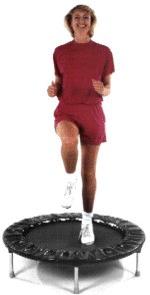
But back to the topic - the aerobic bounce is whatever you want it to be.
You can run, jog, or sprint in place. You can do jumping jacks. You can bounce fast and high.
Just turn on some of your favorite music and get creative with a fun rebounder aerobics routine. Change it up every once in while and you'll never get bored.
Or exercise in front of your favorite TV show.
I like to take it easier when my show is on and then bounce like a mad woman during the commercial breaks. If you think those breaks are long while sitting on the couch, just wait until you're doing some serious bouncing. You'll be begging for your show to come back on.
The bottom line here is that the possibilities are endless. Just be sure that your balance is up to your intensity level.
Otherwise you might just go flying off! Yikes!
The Strength Bounce
This is an easy rebounder exercise in theory. In practice, it's quite hard.
The purpose of the strength bounce is to, you guessed it, build strength.
You really need to make sure that your balance is good before attempting this exercise. At least make sure you are far away from any sharp corners...
The strength bounce involves jumping as high as you possibly can.
Your cells become stronger with higher bounces because you are subjecting them to increased gravitational pull. Remember, the more you resist gravity, the stronger you will become.
Setting up your rebounder workouts around the strength bounce will be quite challenging and rewarding.
The Sitting Bounce
This bounce is a rebounder exercise that serves two purposes.
The first is mainly for those who are in a weakened condition and cannot stand on the mat.
The weakened person sits on the mat while another person behind him bounces lightly up and down. Or if the person is up to it, he can bounce lightly himself.
This small bounce will still flush the lymphatics and boost immune system health.
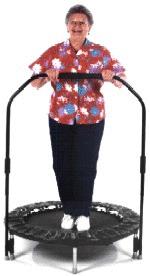
As the person gets stronger, he can move to lightly bouncing while holding a stabilizing bar. Once enough strength is gained so he can stand, then he could start health bouncing and go from there.
The second use for the sitting bounce is to strengthen your core muscles. Sit on the mat, lean back a little and take your feet off the floor. Hold you arms straight out and use them to bounce.
As you get stronger, hold your legs straight out and up so your torso and legs form a V-shape. Only your butt will touch the mat.
This bounce will tone your abs, back, and legs.
It is not a good idea for beginners to try this bounce. Like I said before, start slow.
But the more advanced exercisers might like to use this near the end of their rebounder workout. Finish things off with a minute or two of health bouncing and congratulate yourself on mastering these rebounder exercises.
(photos courtesy of Needak Rebounder)
Health and Wellness Home - Rebounder - Rebounder Exercises

